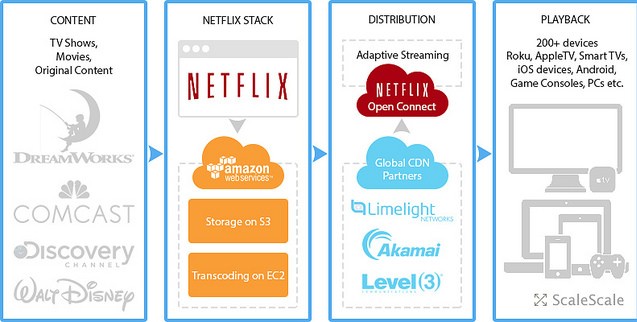
by lovely singh
TO running all of this we need to have a massive network of computer servers, which Netflix once owned on their own, but they realised that the breakneck pace that they grew at — and needed to continue doing so — was difficult if they spent their time building computer systems that can support their software and keep fixing and modifying them to fit their needs. They made a courageous decision to get rid of maintaining their own servers and move all of their stuff to the cloud — i.e. run everything on the servers of someone else who dealt with maintaining the hardware while Netflix engineers wrote hundreds of programs and deployed it on the servers rapidly. The someone else they chose for their cloud-based infrastructure is Amazon Web Services (AWS).

Netflix turned out to be AWS’s most advanced customers, pushing all of their capabilities to the maximum and constantly innovating upon how they can use the different servers AWS provided for various purposes — to run microservices, to store movies, to handle internet traffic — to their own leverage. AWS in turn improved their systems to allow Netflix to take massive loads on their servers, as well as make their use of different AWS products more flexible, and used the expertise gained to serve the needs of thousands of other corporate customers. AWS proudly touts Netflix as it’s top customer, and Netflix can rapidly improve their services and yet keep it stable because of AWS. Even if Netflix takes away Prime Video’s popularity, or vice versa.
Store the original digital copy of the show or movie on to their AWS servers. The original copies are usually in high-quality cinema standards, and Netflix will have to process these before anybody can watch it.
Netflix works on thousands of devices, and each of them play a different format of video and sound files. Another set of AWS servers take this original film file, and convert it into hundreds of files, each meant to play the entire show or film on a particular type of device and a particular screen size or video quality. One file will work exclusively on the iPad, one on a full HD Android phone, one on a Sony TV that can play 4K video and Dolby sound, one on a Windows computer, and so on. Even more of these files can be made with varying video qualities so that they are easier to load on a poor network connection. This is a process known as transcoding. A special piece of code is also added to these files to lock them with what is called digital rights management or DRM — a technological measure which prevents piracy of films.
The Netflix app or website determines what particular device you are using to watch, and fetches the exact file for that show meant to specially play on your particular device, with a particular video quality based on how fast your internet is at that moment.
The last part about fetching is the one that is most crucial for Netflix here, because after all, that is where the Internet network delivers the video from Netflix’s AWS servers to the customer’s device. If it’s poorly managed or ignored, it means a really slow or unusable Netflix and virtually the end for the company. The internet is the umbilical cord that connects Netflix to its customers, and it takes a lot for them to deliver the content a user wants, in the shortest time possible. On a really crowded network where millions of services compete for space.

